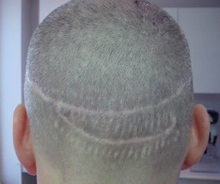
Today’s options for hair growth have gone through a major evolution since 1952 when hair transplantation surgery was first pioneered.
Hair transplant surgery has changed completely — from large to small grafts. The large-graft technique used to be state-of-the-art back then. Treatments have shifted from unnatural-looking transplants to sophisticated new drugs and improvements in hair transplant surgery, like Robotic Hair Transplants- to the future of cloning individual hair cells. The future of hair restoration looks even brighter than the present.
According to estimates form the U.S. Food and Drug Administration (FDA), 40 million men and 20 million women experience hair loss.
To perform a hair transplant, Dr. Mark Bishara obtain skin grafts with hair follicles from places on the scalp that are still growing hair (typically the back or side of the head) and transplant them into the balding areas where it will continue to grow. Today, surgeons use smaller grafts which contain anywhere from one to five hair follicles per graft; this helps give the scalp a more natural appearance. By contrast the larger grafts had 15-20 hair follicles; they looked artificial with the appearance of rows of hairs. These are known as hair plugs.

For the very latest technology in hair restoration, Dr. Bishara is now using the ARTAS System.This physician-controlled, state-of-the-art system enables the harvesting of hair follicles during hair restoration procedures. It offers numerous beneficial features, including an image-guided robotic arm, special imaging technologies, small dermal punches and a computer interface. The ARTAS System is capable of identifying and harvesting individual follicular units to implement the FUE technique. The device, guided by cameras and 3-D imaging software, can perform the dissection of hair follicles individually at a rate of up to 1,000 per hour.
FUE offers less discomfort and a faster return to normal daily activities than traditional, more invasive methods of hair restoration. Performed in Dr. Bishara’s office, FUE with ARTAS moves healthy, functioning follicles to the areas of the patient’s scalp most impacted by baldness for more dramatic results. The implanted hairs develop their own blood supply, begin to grow and new hairs are seen a few months after the procedure has taken place. New hair continues to grow over the course of a full year, making the change in the patient’s appearance gradually noticeable to others. Healing time is short, and there is no resultant linear scar as happens with other methods of hair restoration. The only evidence is tiny, white scars left in the donor area, which are the same as those produced by manual FUE.
In the case of hair transplantation, going from large grafts of hair to small grafts was what made this procedure so much more natural and because of this, more people doing better transplants today.


The Evolution Continues
Hair transplantations have continued to evolve into smaller and smaller grafts and the next step will be to add a cell-based transplant where you can inject hair seeds into the balding area that can grow into a brand new follicle (cloning). Within five years, we should be able to augment and add this to the follicle-based transplant. Cloning has certainly become possible in other areas, so it is very possible that there will come a time when hair can be cloned. If hair cloning can work that would give us the best ability to restore hair. It would deliver the best results, physically and cosmetically.
Dr. Mark Bishara is proud to offer a wide range of comprehensive hair restoration procedures. Combined with his extensive experience and advanced skills, these procedures are often highly effective. The best treatment option for each patient depends on the location and extent of hair loss. Dr. Bishara will take the time to evaluate each patient, discuss his/her individual goals and together develop a personalized treatment plan using one of his many successful hair loss treatment options. Please call our office at (817) 473-2120 or visit our website for more information at www.MarkBisharaMD.com.









